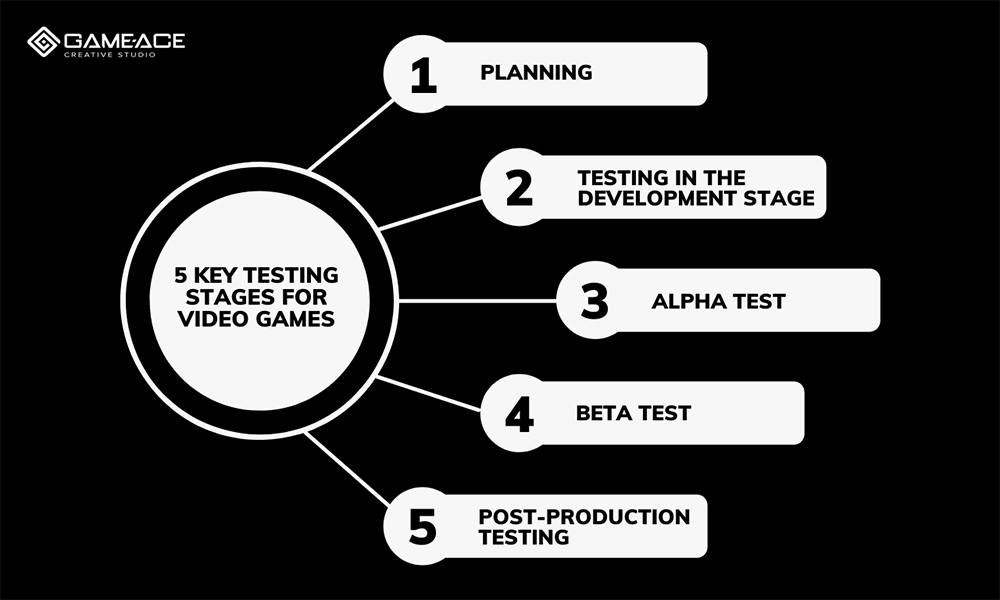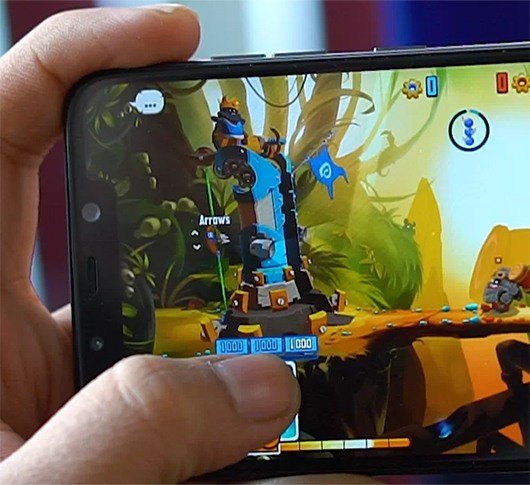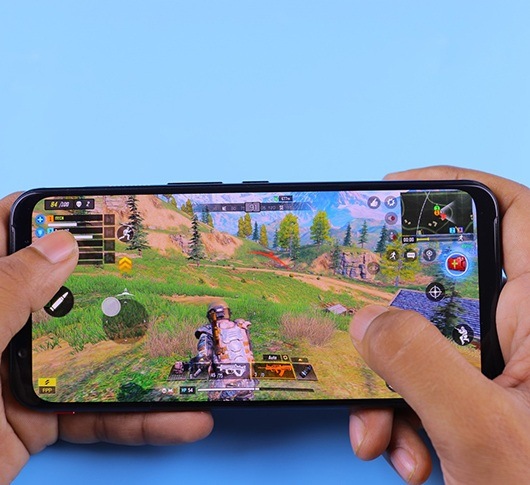Game testing is an essential stage in development that should not be taken lightly. Also known as quality assurance (QA), this also happens to be a complex process with many game test stages that you should know to get the most out of the process.
In this article, we’ve described the main stages of the video game testing and highlighted some helpful tips from professional experience. We also look at how game testing services can make the process easier for game development companies and publishers.
Stages of Video Game Testing

It’s generally accepted that there are five key testing stages for video games: planning, testing in the development stage, Alpha test, Beta tests, and post-production testing. Let’s examine them in more detail.
1) Planning
Planning is an obligatory stage of high-quality testing. In this phase, testers gather information by communicating with product owners and developers to understand basic game mechanics, flow, narrative, etc. This information is then used to build a testing strategy formulated in a document.
The strategy usually consists of the basic info about game testing types, stages, and tools that will be used during the process. This prevents wasting time on questions that could be solved at the beginning of a project.
Pro Tip: Create a game design document that will include well-detailed game development stages and the information about a product and its requirements. This ultimate document will help at every following stage of video game testing.
2) Testing in the development stage
Some people think that only completed games can be tested, but it’s a common misconception. Developers are the first specialists who start game testing as they work. They use different testing types like unit testing (which checks separate source code for issues and errors). In addition, devs test basic functionality to ensure that everything works properly.
Quality assurance in the development stage prevents and fixes many fundamental and sometimes critical issues. As a result, you avoid spending extra time and effort fixing these bugs later and they don’t snowball into something bigger.
Pro Tip: Use the AAA method — Arrange, Act, Assert, which means: pick a unit, arrange all the parameters, act as a testing case and assert that the result matches expectations.
3) Alpha test
Once developers have finished building a game and are satisfied that it functions at least on a basic level, it’s time for deep quality assurance. So what is the Alpha stage of game testing? Alpha testing (or closed Alpha) is conducted by a team of QA engineers. This phase takes the most time and effort in the entire testing life cycle.
QA engineers check the quality of different game components, applying the main types of game testing: functional and non-functional testing. For example, load testing checks the capability of a game to work under a load of various quantities of users at once, while localization testing ensures that specific settings based on location (language, time zone) are adapted automatically.
Pro Tip: Every test type of the Alpha stage should be run one-by-one. It’s better to start with Smoke testing, as this type is aimed at surface testing, and proceed from there.
4) Beta test
Right after the Alpha testing stage, a game should be mostly bug-free and almost ready to release. However, it has not been shown to a broader audience and those who will actually play it. Thus, beta testing involves real fans and gamers to gather input and make some final changes before release.
So how do you test games with Beta? It’s usually done in two phases: Closed Beta and Open Beta. Let’s look at the difference.
-
Closed Beta. This testing type is conducted by real people who mimic the behavior of the gamers. Usually, such non-professional testers are still people whose work is related to game development. The number of participants is limited (50-100 people), so QA engineers invite them to find the minor bugs in non-public testing.
-
Open Beta. Open Beta test of games is a pre-release process where everyone who wants can participate. Usually, it’s gamers who are already interested in a new product, so they sign up for an Open Beta test, get access to a game and send their feedback to the QA department. This testing is often about UX/UI impressions, but sometimes, users find some minor bugs.
Pro Tip: Each piece of feedback is precious, so don’t hire too many people for Beta testing, as you may be overwhelmed with reports that will take months to process and filter for useful information.
5) Post-production testing
You think that testers can move on to other things once the aforementioned steps are complete. However, it’s still not the end of the story.
Game release is usually accompanied by user feedback. Gamers might find bugs or make complaints that need to be addressed. As a result, developers update different game parts that must be tested to avoid damaging the whole game. Thus, QA support remains integral even when the main job is done.
Pro Tip: Use previous testing reports while developing and testing updates. This way, you’ll have a better chance at understanding of what might be causing new bugs.
Free yourself from testing – use professional game testing services!
How to Test Games for Different Platforms
When testing any game, it’s vital to ensure the quality of its basic components: gameplay, graphics, controls, UX/UI, multiplayer mode, etc. But testing games for different platforms has various peculiarities that should be kept in mind.
PC. Testing PC games involves the most traditional approaches to QA. It’s necessary to try running the software with specs from minimal to the most powerful to gauge which segment of the overall player population will be able to enjoy it. Finding loopholes is another significant testing task, since it is common for some PC gamers to try hacking a game to get an unfair advantage.
Mobile. As mobile games are made for small-sized devices, mobile game testing requires ensuring that:
- multi-touch devices recognize gestures correctly;
- text size is optimal for reading;
- the game is adapted for different resolutions and device models.
Consoles. QA of a console game involves testing a product on target generations of devices — PS, Nintendo, Xbox. In a way, it can be more manageable than testing on PCs and mobile, as the testing environment is more stable and the quantity of platforms is fewer.
Web. Testing web games also implies considering the requirements of different browsers — Chrome, Opera, Safari, etc. Because such a game’s performance depends on the Internet connection, it’s especially important to pay attention to stability testing and how accurate features like social media, registration, and age verification have been implemented.
VR/AR. Testing VR games can be tricky, especially during Beta testing. One of the components of a game is motion in a three-dimensional surrounding, but many people in VR get motion sickness. So, first of all, someone has to keep an eye on the tester.
On the other hand, AR games should be accurately tested for high-quality and timely 3D visualizationsin the real environment. This means checking whether an app scans the surroundings well, loads the game fast, and projects models of augmented reality as intended.
Outsourcing Video Game Testing Services to Improve QA
It’s easy to see that quality game testing is a complex process involving many stages, test types, and special features. Luckily, you can always make the process easier for yourself by relying on professionals who have been doing it for a long time.
Game-Ace is an experienced game development studio that helps clients in different aspects of game development/design, as well as assuring its quality. Our team of experts is ready for new challenges, so you can count us in when it comes to polishing and improving your product.
Contact us to discuss the details of your project and start preparing for a successful game launch!
 Mobile Game Testing: Types, Tools, and More
Mobile Game Testing: Types, Tools, and More  Understanding the Role of QA Game Testers in Game Development Projects
Understanding the Role of QA Game Testers in Game Development Projects  Game QA Companies: What Is Their Role and How to Choose the Best?
Game QA Companies: What Is Their Role and How to Choose the Best?  Android Game Testing: Things to Keep in Mind and Check
Android Game Testing: Things to Keep in Mind and Check  What Are the Main Types of Game Testing? Your Questions Answered
What Are the Main Types of Game Testing? Your Questions Answered 


































